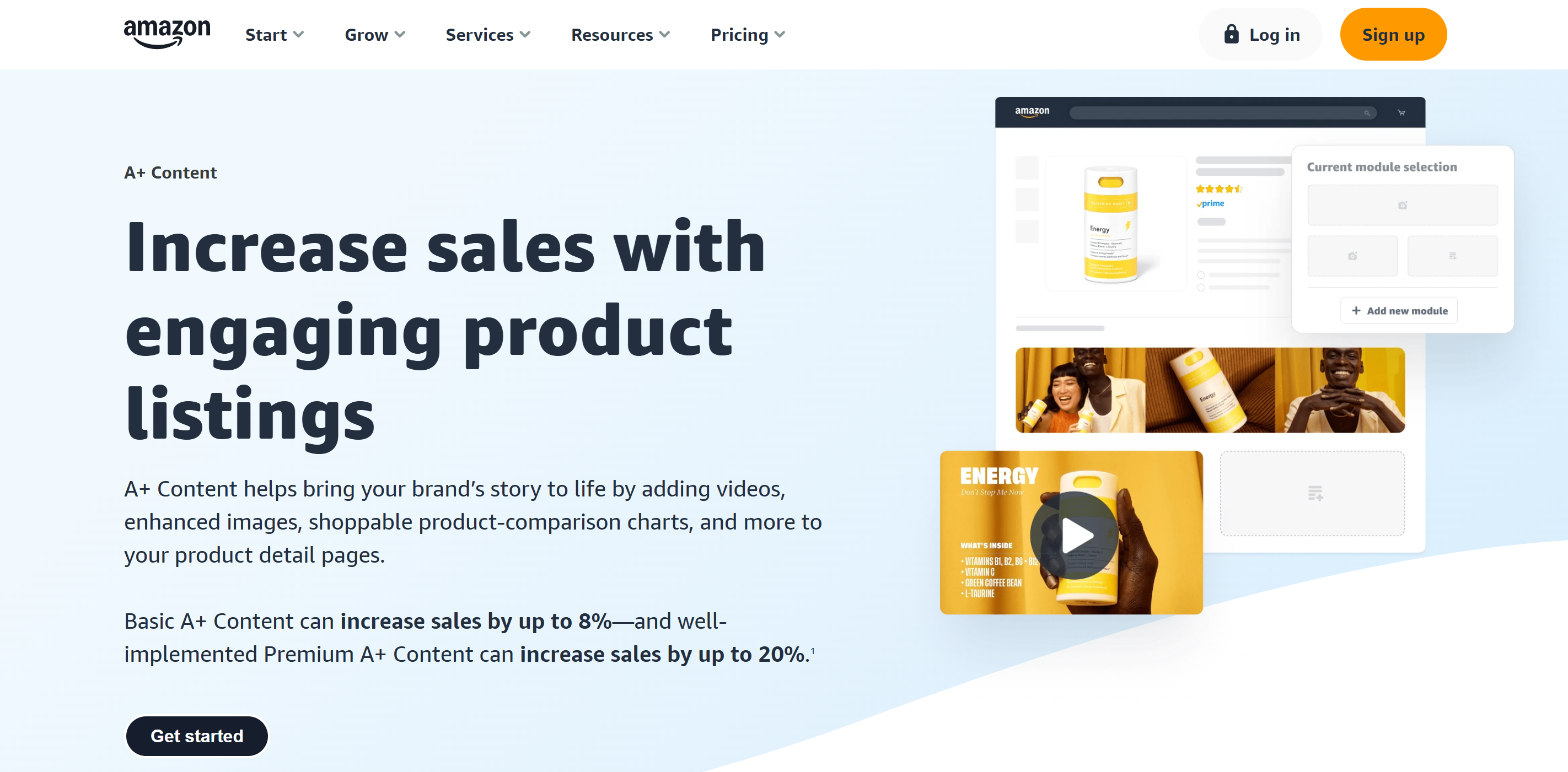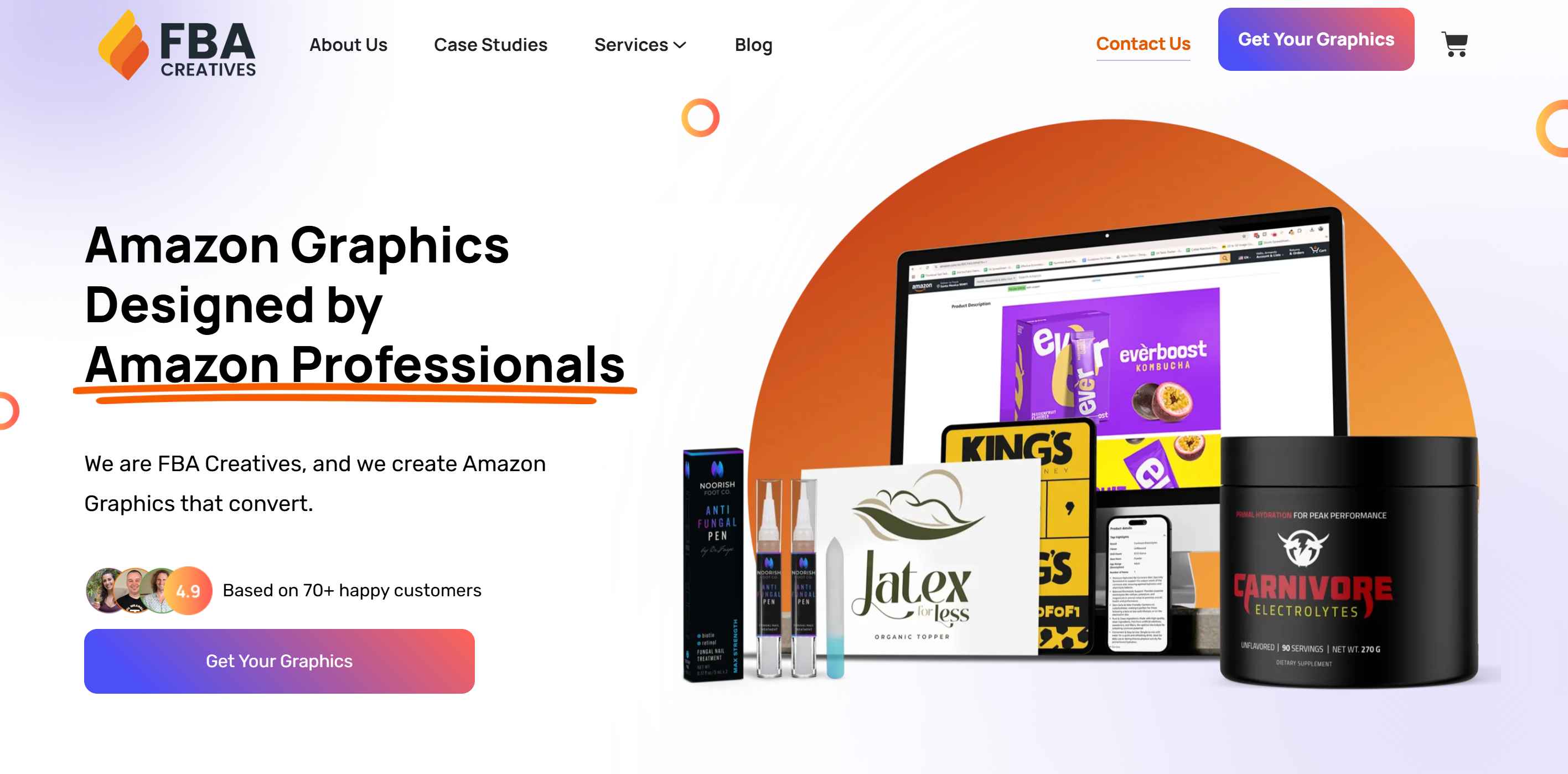
Tailoring A+ Content to the Amazon Algorithm | Boost Rankings & Conversions
Tips That Actually WorK
In the ever-evolving world of e-commerce, staying ahead of the competition on Amazon is more critical than ever. One of the most powerful tools at a brand’s disposal is A+ Content—a premium content feature that allows brand owners to enrich their product detail pages with enhanced visuals, comparison charts, and storytelling elements. However, merely adding attractive images and text isn’t enough.
To truly capitalize on A+ Content, it must be strategically aligned with the Amazon algorithm. The algorithm, which decides how products appear in search results, prioritizes listings that engage users, convert well, and provide relevant information. This means that beautifully designed content is only effective if it’s also optimized for discoverability and performance.
In this comprehensive guide, we’ll explore how to tailor your A+ Content to meet the expectations of Amazon’s algorithm—maximizing visibility, boosting conversions, and positioning your brand for long-term success.
- Understanding the Amazon Algorithm
- What is A+ Content and Why It Matters
- Keyword Optimization & Research Strategies for A+ Content
- Crafting Visually Compelling A+ Content
- Storytelling that Converts
- A/B Testing and Iterating Your A+ Content
- Most Common A+ Content Mistakes
- Leveraging Enhanced Brand Content Analytics
- Expert Agencies Vs DIY: What should you do?
- Staying Updated with Amazon’s Constant Algorithm Changes
- Final Checklist for A+ Content Success
- Long-Term Success: The Future of A+ Content on Amazon
- Frequently Asked Questions (FAQs)
Understanding the Amazon Algorithm

What is the Amazon A10 Algorithm?
Amazon’s search algorithm, often referred to as A10, is the engine behind every product search. Unlike Google’s algorithm, which focuses on informational searches, Amazon’s primary goal is to generate sales. Therefore, it evaluates listings based on how likely they are to convert.
The A10 algorithm analyzes a variety of signals including keyword relevance, pricing, product availability, and customer behavior to determine which listings should appear higher in search results. As sellers, understanding the core mechanisms of this algorithm is essential. If your content doesn’t align with Amazon’s logic, it risks being buried—even if your product is excellent.
Ranking Factors That Matter Most
Several performance indicators feed directly into the Amazon algorithm:
- Conversion Rate: The higher your conversion rate, the more Amazon will trust your product to generate revenue.
- Keyword Relevance: Your listing should contain the keywords users are searching for—but used naturally.
- Customer Reviews: Positive reviews indicate buyer satisfaction, signaling to Amazon that your product is reliable.
- Content Quality: High-quality visuals, clear descriptions, and compelling branding all keep customers engaged—and that signals value to the algorithm.
Ultimately, the Amazon algorithm rewards listings that provide a frictionless customer experience. And A+ Content is a significant part of that equation.
What is A+ Content and Why It Matters
Defining A+ Content on Amazon

A+ Content allows registered brand owners to enhance their product pages with additional visual elements and text modules. There are two tiers: Basic A+ Content, which includes image and text modules, and Premium A+ Content, which introduces advanced features like interactive hotspots and video.
These modules not only enhance your product presentation but also help communicate your brand’s story and values. Eligibility is typically granted to brand-registered sellers, and the implementation is done through Amazon’s advertising console.
How A+ Content Impacts the Amazon Algorithm
Although A+ Content isn’t directly indexed by Amazon’s algorithm for search ranking, it plays a vital indirect role. Here’s how:
- Reduced Bounce Rate: Engaging visuals and well-structured information keep users on the page longer.
- Improved Conversion Rates: When shoppers are presented with more detailed, visually appealing content, they’re more likely to make a purchase.
- Fewer Returns: A+ Content clarifies product specifications and usage, reducing the chances of customer dissatisfaction.
- Customer Trust: Professional presentation builds credibility, a factor that often leads to higher review scores and repeat purchases.
Therefore, while the algorithm may not “see” your A+ Content in the traditional keyword-based sense, it absolutely rewards its results.
Keyword Optimization & Research Strategies for A+ Content

To tailor your A+ Content to the Amazon algorithm, you must begin with thorough keyword research. The algorithm favors listings that match the search intent of users, and identifying the right keywords gives you a competitive edge from the start.
Leverage tools like Helium 10, Jungle Scout, and Amazon’s own auto-suggestions to uncover high-converting, relevant search terms. Focus not just on high-volume terms, but also on long-tail keywords with strong purchase intent. These often face less competition and align closely with buyer-specific needs.
For instance, instead of targeting a broad term like “kitchen knife,” you might find better traction with “professional Japanese chef knife.” Integrating such intent-driven keywords into your A+ Content ensures that it resonates with your target audience while supporting broader SEO efforts.
Where and How to Integrate Keywords
Although A+ Content modules are not indexed for direct search ranking, the alt-text of images and backend keyword fields still carry SEO weight. That’s where your research pays off.
- Use keywords in alt-text descriptions for all images. This improves accessibility and gives the algorithm a subtle but valuable data point.
- Optimize your backend search terms with variations and related phrases.
- Write compelling headlines for A+ modules that include keywords naturally—this helps engage users and improves scanability.
Avoid keyword stuffing. The Amazon algorithm can detect unnatural patterns and may penalize listings that appear spammy. Instead, focus on contextual relevance—ensure each keyword enhances the narrative and delivers value to the reader.
Crafting Visually Compelling A+ Content
Best Practices For Amazon Images
On Amazon, visuals do much of the heavy lifting. With A+ Content, you have the chance to go far beyond standard product photos and bring your brand story to life. To truly captivate shoppers and gain favor with the Amazon algorithm, your imagery must be both strategic and high quality.
- Use lifestyle images that show the product in real-world scenarios. This helps customers visualize usage and builds emotional connection.
- Comparison charts can simplify decision-making and reduce bounce rates—something the algorithm rewards.
- Ensure all images are high-resolution, mobile-optimized, and free from excessive text or clutter.
- Maintain consistent branding with colors, fonts, and logo placement to strengthen brand recognition.
Not only do striking images improve user engagement, but they also contribute to lower bounce rates and higher conversions—two crucial behavioral signals that the algorithm tracks closely.
Optimal Layout and Module Strategy

Every product is unique, and so should be its A+ Content structure. Amazon provides multiple modules, from standard image-and-text layouts to more dynamic combinations. Selecting the right layout involves understanding your audience and the product’s key selling points.
- Start with a hero banner that sets the tone and communicates brand authority.
- Use a feature highlight module to outline your top three benefits.
- Incorporate a Q&A or troubleshooting section to preempt common objections.
Ultimately, your layout should tell a story. The smoother the flow, the better the user experience—and that, once again, feeds directly into the Amazon algorithm’s performance metrics.
Storytelling that Converts

In a space dominated by visuals and short attention spans, your words still matter immensely. Great storytelling turns browsers into buyers. Instead of overwhelming users with specs, focus on the benefits and emotional triggers that matter to them.
Use clear, concise, and benefit-driven language that communicates exactly how your product solves a problem or enhances a lifestyle. Incorporate buyer-centric language like “you’ll love how this…” or “designed for your everyday needs.”
Avoid technical jargon unless absolutely necessary, and break longer blocks of text into bite-sized, digestible chunks. Every sentence should drive the user closer to making a purchase.
How To Use Brand Voice to Connect
Your brand voice is not just a stylistic preference—it’s a trust-building mechanism. When done right, it builds emotional loyalty and makes your listing feel more like a conversation than a pitch.
Establish a tone that fits your audience. If you sell luxury goods, use elegant and refined language. If your brand is playful and fun, let that come through. The goal is to humanize your brand, making it memorable and relatable.
Brands that successfully convey their identity through A+ Content tend to see stronger customer retention and improved conversion rates—both of which enhance your listing’s performance in Amazon’s algorithm.
A/B Testing and Iterating Your A+ Content

Creating your A+ Content is just the beginning. To truly tailor it to the Amazon algorithm, you need to continuously test and refine your strategy. This is where A/B testing comes into play.
Amazon offers Manage Your Experiments, a powerful tool that allows brand-registered sellers to test different versions of their A+ Content. You can compare two layouts, messaging styles, or image sets to see which performs better over time. The platform provides data on impressions, click-through rates, and conversions—giving you clear insights into customer preferences.
By experimenting methodically, you can make data-driven improvements that align more closely with what the algorithm values: higher engagement and increased conversions.
Learning From Customer Behavior
While testing tools provide helpful analytics, it’s equally important to monitor customer behavior patterns more broadly. Dive into your Seller Central performance reports and analyze:
- Session duration: Are users staying long enough to engage with your A+ Content?
- Click-through rate (CTR): Is your content enticing shoppers to explore more?
- Return reasons and reviews: Are there recurring points of confusion or dissatisfaction?
Using this feedback loop, you can identify content gaps or misalignments that may be undermining your performance—and adjust accordingly. Remember, the Amazon algorithm rewards listings that consistently satisfy customer expectations.
Most Common A+ Content Mistakes

Keyword Stuffing and Overloading Images
One of the most common pitfalls sellers face is over-optimizing. In an effort to “game” the Amazon algorithm, some listings become overloaded with keywords and bloated visuals. This can actually do more harm than good.
Keyword stuffing—repeating keywords unnaturally in alt-text or image captions—can make your listing look spammy. Amazon’s algorithm detects this and may penalize you with lower visibility. Worse, it creates a poor user experience, which drives up bounce rates and signals a lack of relevance.
Similarly, cramming too much information into a single image creates clutter and confusion. A+ Content should feel clean, easy to scan, and intuitive. Your goal is to guide the shopper—not overwhelm them.
Inconsistent Branding and Low-Quality Visuals
Consistency builds trust, and on Amazon, trust drives conversions. A major mistake many sellers make is using inconsistent branding elements across their A+ modules. When fonts, colors, or messaging tone vary drastically, it creates a fragmented experience that erodes brand credibility.
Low-resolution or poorly edited images also damage your brand’s perception. Given how visual Amazon is, blurry or pixelated images can be a dealbreaker. Invest in professional visuals that reflect your product’s quality and attention to detail.
If branding isn’t your forte, this is where expert help can make all the difference—especially when the goal is to align your content with Amazon’s best-performing standards.
Leveraging Enhanced Brand Content Analytics
Once your A+ Content is live, your job isn’t over. Amazon provides powerful Enhanced Brand Content (EBC) analytics that can guide your ongoing optimization efforts. These metrics give you visibility into how your A+ Content is influencing shopper behavior.
Look at key performance indicators such as:
- Impressions: How many users are viewing your content
- Engagement: Are users scrolling through modules or bouncing quickly?
- Conversion Rate: How many views are turning into actual sales?
These analytics provide actionable insights. For instance, if one module has a significantly higher engagement rate, you may want to replicate its structure across other listings.
Aligning Content with Performance Goals
The ultimate goal of A+ Content is to drive measurable results. Whether that’s increasing unit session percentage, improving brand recognition, or reducing return rates, you must ensure your content strategy aligns with these objectives.
This is where hiring experts can be incredibly valuable. Agencies like FBA Creatives specialize in analyzing EBC data and refining layouts, visuals, and copy for maximum performance. They understand the subtleties of the Amazon algorithm and how to translate them into high-converting content strategies. By partnering with professionals, brands often save time, reduce costly errors, and achieve faster ROI.
Expert Agencies Vs DIY: What should you do?

While many brands start their A+ Content journey in-house, there often comes a point where professional expertise becomes essential. If your product pages aren’t converting as expected, your bounce rate remains high, or your branding feels inconsistent, these are clear signs it’s time to get help.
Amazon’s marketplace is increasingly competitive, and tailoring A+ Content to the Amazon algorithm requires both creative skill and strategic insight. Experts can help you avoid common mistakes, test what works, and scale successful layouts across your catalog.
Most importantly, they can guide you in making data-backed decisions, rather than relying on guesswork. This not only improves short-term performance but sets you up for long-term brand equity on the platform.
The Only Design Agency Tailored for Amazon

Among the standout partners for A+ Content design is FBA Creatives—a team of specialists that understands both the visual and algorithmic aspects of selling on Amazon. Their approach blends artistic storytelling with conversion-focused strategy, which is exactly what the algorithm favors.
FBA Creatives is known for crafting visuals that reduce buyer hesitation and for using layout psychology to guide decision-making. They’ve helped numerous sellers scale revenue by transforming underperforming product pages into high-converting digital storefronts.
While you don’t need to outsource everything, collaborating with an experienced partner like FBA Creatives can be a smart move—especially when you’re ready to compete at a higher level.
Staying Updated with Amazon’s Constant Algorithm Changes
One thing that’s constant about the Amazon algorithm is that it never stays the same. Amazon continually updates its systems to better serve shoppers and promote high-quality content. This means that even well-optimized listings can lose traction if they aren’t updated regularly.
Recent changes have placed more emphasis on customer experience metrics, like dwell time, return rate, and content engagement. Amazon wants to ensure that the listings it ranks highest are the ones providing the most value to customers.
Keeping up with these changes requires ongoing education, testing, and sometimes even reworking your A+ Content strategy. It’s a dynamic environment, but one where agile brands can thrive.
Staying Ahead of Competitors
To stay ahead, it’s not enough to simply react—you must anticipate trends. That means following industry blogs, monitoring top-performing listings in your niche, and experimenting with new formats.
Regularly auditing your A+ Content ensures that you remain aligned with Amazon’s latest priorities. Are your images up to date? Is your copy reflecting seasonal trends? Are your keywords still relevant?
Staying proactive gives you a significant advantage. While competitors are scrambling to adapt, your brand can remain confidently ahead, already in sync with what the Amazon algorithm is favoring today.
Final Checklist for A+ Content Success
Quick Self-Assessment Questions
Before you consider your A+ Content finished, it’s important to run a final audit. Use these key questions to ensure every element is aligned with the expectations of the Amazon algorithm and ready to drive conversions:
- Have you clearly articulated your product’s unique selling points?
- Are your images high-quality, professional, and relevant?
- Do your headlines include naturally placed keywords?
- Is your content layout optimized for both desktop and mobile devices?
- Have you added keyword-rich alt-text to your images?
- Are your design elements consistent with your brand identity?
If you answered “no” to any of the above, your A+ Content likely still has room for improvement.
Common Pitfalls to Re-Audit
Even seasoned sellers can overlook some of the more subtle performance barriers. Watch out for:
- Too much text: Avoid cramming large paragraphs into your modules—keep copy concise and skimmable.
- Unclear brand messaging: Your content should immediately communicate who you are and why shoppers should trust you.
- Missing comparison charts: These are particularly helpful in crowded niches and can significantly boost conversion.
- Unoptimized mobile layout: More than half of Amazon shoppers browse on mobile—ensure your modules scale well on smaller screens.
When in doubt, review your top competitors and identify what they’re doing better. Continuous benchmarking keeps you sharp and helps ensure your content doesn’t fall behind evolving standards.
Long-Term Success: The Future of A+ Content on Amazon
The Future of A+ Content on Amazon
As Amazon evolves, so too will the role of A+ Content. It’s no longer just an optional branding tool—it’s a performance driver. In the near future, we can expect even deeper integration between A+ Content and other platform features like video, voice search, and cross-channel marketing.
Amazon is also likely to further reward brands that provide seamless, informative shopping experiences. That means sellers who embrace data-backed content strategies, invest in storytelling, and prioritize user experience will continue to gain favor in the algorithm.
Final Thoughts
In summary, tailoring your A+ Content to the Amazon algorithm isn’t just about aesthetics—it’s a holistic strategy that combines creativity, user psychology, and SEO principles. By aligning your content with what the algorithm rewards—conversion rates, customer engagement, and clarity—you position your brand for higher visibility and stronger sales performance.
And remember, you don’t have to go it alone. When you’re ready to scale or refine your strategy, bringing in experts like FBA Creatives can provide the edge you need. With professional insights and results-driven design, they help brands turn browsers into loyal buyers.
Invest in your content, and your performance will follow.
Frequently Asked Questions (FAQs)
1. Does A+ Content directly affect my Amazon SEO rankings?
Not directly. The text in A+ Content isn’t indexed by Amazon’s search engine. However, it influences performance metrics like conversion rate and bounce rate, which are very much part of the algorithm’s ranking signals.
2. What’s the difference between Basic and Premium A+ Content?
Basic A+ Content includes standard image and text modules. Premium A+ Content, available to select sellers, offers advanced features like video, interactive hotspots, and carousel modules for a richer experience.
3. How often should I update or test my A+ Content?
Ideally, review your A+ Content every 3–6 months. Regular A/B testing and performance analysis will help you stay aligned with Amazon’s updates and customer expectations.
4. Can I create effective A+ Content without hiring a designer?
Yes, but it requires time, effort, and a solid understanding of layout psychology, copywriting, and Amazon’s module system. If you lack bandwidth or design experience, hiring professionals like FBA Creatives is a smart move.
5. Is it worth investing in agencies like FBA Creatives for content development?
Absolutely. A professional team can fast-track your optimization process, ensure visual consistency, and tailor your content specifically to drive conversion—all while aligning with the Amazon algorithm.
Have an Amazon product in mind?
We handle your entire Amazon listing from start to finish — including your title, listing images, A+ Content, and even your Brand Storefront.








